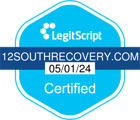In the realm of pain management, two commonly prescribed medications often come into consideration: Vicodin and Percocet. While both are effective in alleviating moderate to severe pain, they differ in their composition, potency, and potential risks. At 12 South Recovery, we recognize the significance of understanding these disparities to empower individuals to make well-informed decisions regarding their health and treatment options. In this guide, we’ll look at the intricate details of Vicodin and Percocet, shedding light on their mechanisms of action, therapeutic effects, adverse reactions, and addiction potential.

Understanding Vicodin and Percocet
Vicodin and Percocet, two commonly prescribed pain medications, combine opioids with acetaminophen to provide effective relief for moderate to severe pain.
Vicodin:
Vicodin blends hydrocodone, an opioid analgesic, with acetaminophen, a non-opioid pain reliever and fever reducer. Hydrocodone acts by binding to mu-opioid receptors in the central nervous system, altering pain perception and inducing analgesia. Beyond pain relief, hydrocodone’s interaction with neurotransmitter systems within the CNS may contribute to feelings of euphoria and relaxation, though this also increases the risk of dependency and addiction. Acetaminophen in Vicodin works synergistically with hydrocodone by inhibiting prostaglandin synthesis, thereby enhancing pain relief and reducing fever.
Percocet:
Percocet follows a similar pattern, combining oxycodone, a potent opioid agonist, with acetaminophen. Oxycodone exerts its analgesic effects by binding to mu-opioid receptors in the brain and spinal cord, modulating pain transmission and perception. Like hydrocodone, oxycodone’s activation of the brain’s reward pathways may lead to euphoria and addiction. The inclusion of acetaminophen in Percocet formulations enhances oxycodone’s analgesic potency by inhibiting COX enzymes, reducing prostaglandin levels, and amplifying overall pain relief.
Understanding the nuanced mechanisms of action of Vicodin and Percocet underscores the importance of informed decision-making in pain management. It also highlights the necessity of responsible medication use, close monitoring, and comprehensive addiction prevention strategies.
Understanding the Differences
When comparing Vicodin and Percocet, several key differentiators emerge:
- Potency: Percocet is generally considered to be more potent than Vicodin due to its oxycodone content. Oxycodone is approximately 1.5 times more potent than hydrocodone, necessitating lower doses for equivalent pain relief.
- Opioid Component: While both medications contain acetaminophen, they utilize different opioid analgesics—hydrocodone in Vicodin and oxycodone in Percocet. The choice between the two may depend on individual patient factors, including pain severity, tolerance, and previous medication response.
- Formulation Variants: Both Vicodin and Percocet are available in various formulations, including immediate-release and extended-release formulations. These formulations differ in their onset of action, duration of effect, and dosing frequency, catering to diverse patient needs and preferences.
Effects and Risks of Vicodin and Percocet
Despite their therapeutic efficacy, both Vicodin and Percocet carry inherent risks and potential side effects:
- Common Side Effects: Nausea, vomiting, constipation, dizziness, drowsiness, and respiratory depression are among the most frequently reported side effects associated with opioid medications.
- Gastrointestinal Effects: Opioid analgesics, including Vicodin and Percocet, can impair gastrointestinal motility, leading to constipation, bloating, and abdominal discomfort. These effects may necessitate the use of adjunctive medications or lifestyle modifications to mitigate gastrointestinal symptoms.
- Respiratory Depression: One of the most serious risks associated with opioid use is respiratory depression, characterized by decreased respiratory rate and depth. Respiratory depression can be life-threatening, particularly in individuals with pre-existing respiratory conditions or compromised pulmonary function.
- Risk of Dependency and Addiction: Prolonged use of opioid medications, such as Vicodin and Percocet, carries a significant risk of tolerance, dependency, and addiction. Chronic opioid therapy can lead to neuroadaptive changes in the brain’s reward pathways, fostering addictive behaviors and cravings for continued opioid use.
Treatment Options
If you or someone you know is struggling with addiction to Vicodin, Percocet, or other opioid medications, seeking professional help is crucial for recovery. At 12 South Recovery, we offer a comprehensive range of addiction treatment services tailored to meet the unique needs of each individual:
- Medical Detoxification: Our medically supervised detoxification program provides a safe and supportive environment for individuals undergoing withdrawal from opioids. Our experienced medical team utilizes evidence-based protocols and medications to alleviate withdrawal symptoms and ensure a comfortable detoxification process.
- Individualized Therapy: We offer individual and group therapy sessions facilitated by licensed therapists who specialize in addiction treatment. Through cognitive-behavioral therapy (CBT), dialectical behavior therapy (DBT), and other evidence-based modalities, we address underlying issues contributing to addiction and teach coping skills for relapse prevention.
- Medication-Assisted Treatment (MAT): MAT combines FDA-approved medications with counseling and behavioral therapies to treat opioid use disorder effectively. Medications such as buprenorphine, methadone, and naltrexone can help reduce cravings, alleviate withdrawal symptoms, and support long-term recovery.
- Dual Diagnosis Treatment: Many individuals with opioid addiction may also struggle with co-occurring mental health disorders such as depression, anxiety, or post-traumatic stress disorder (PTSD). Our dual diagnosis program provides integrated treatment for both substance use disorders and mental health conditions, addressing the interconnected nature of these issues.
- Holistic Modalities: In addition to traditional therapeutic approaches, we offer holistic modalities such as yoga, mindfulness meditation, art therapy, and acupuncture to promote holistic healing and well-being. These complementary therapies complement our clinical interventions, fostering physical, emotional, and spiritual growth in recovery.
Reach Out to Us Today!
Don’t let opioid addiction control your life any longer. Take the first step towards recovery by reaching out to 12 South Recovery at 866-311-4524. Our compassionate team is here to provide personalized treatment and support, empowering you to overcome addiction and live a fulfilling, substance-free life.


















